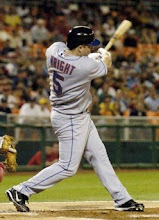I've posted this story once already, but I thought I should 
recycle it. It's been slow in regard to Mets news.
There are two reasons why trading for Johan Santana is a terrible baseball move and an equally terrible business move.
The first is that Santana has only one year remaining on his contract. Why in the world would a baseball team give up many many years of cost controlled future talent for someone that they could simply wait one more season and then sign as a free agent?
The only possible reason for doing so would be if a team believed it wouldn't be able to compete with Boston and the New Yorks in the free agent market. In order to trade for Santana, his suitor would have to sign him for around 7 years and $150 million or Santana would void the trade. If a team can afford to trade for Santana, they can afford to bid for him in the free agent market.
The reality for all of his suitors, teams are left with weighing the idea of trading bunches of future and current talent for one extra year of a very good pitcher in decline. (I'll get to that in a minute.)
The second reason is that Johan Santana is 29 years old and in decline. Santana is a fantastic pitcher, and it’s possible that last season was an aberration, but considering the amount of money needed to sign him and the amount of players necessary to complete a trade, it would be a huge and potentially very costly gamble to bet on Santana. The smartest move is to assume a wait and see approach, and so far, all of Santana’s suitors have taken that approach.
He's not in decline you say! What makes the Santana issue confusing to some is that even in his worst season as a starting pitcher, Santana was very good. However, only an extremely foolish General Manager would overlook the direction Santana’s career took last season. Santana lost more games then he ever has in his career, but more importantly he posted his highest era, walked more batters per 9 innings, posted his lowest strike out to walk ratio, and allowed opposing batters to hit for their highest batting average, highest OBP, and higherest SLP against him since he become a full time starter in 2004. He also allowed only 3 less hits than his career high despite pitching 14 less innings and he allowed significantly more home runs.
Despite all of this, Santana is still very good. The numbers, however, act as a huge red flag in the eyes of general managers. Trading prospects for proven talent is often a good idea but the amount of young talent that must be sent away and the amount of money needed to sign Santana makes the proposition of a trade happening a truly unlikely one. Despite the urging of fans.



2 comments:
Good stuff DJ.. I agree 100% with what you said.
I disagree.
On the business side, you can't simply "wait and see" what happens in free agency because he'll never get there. The Twins know that Santana will not re-sign, and must trade him. If there are one or more teams willing to pay him (and obviously there are) then the only way for such a team to obtain him would be by trade. The Twins will simply accept the best available trade package rather than letting him walk for nothing.
On the baseball side, you get a 2-time Cy Young winner who in his "worst" season still pitched 200+ innings with a 3.3 era and 15 wins. For most pitchers that would be a career year. Moreover, MLB pitchers are not like NFL running backs & don't collapse at 30. Good pitchers often remain in their prime well through their mid & late 30's, or later. Even with a 6 year deal, Santana would still be due to come off the books by age 36, and even then might still in his prime.
If you aren't taking issue with the gigantic size of the contract it would take to sign him- which you aren't if you're advocating for a run at him in free agency instead of trade- then there is simply no way to criticize a team for trying to acquire him through trade.
Post a Comment